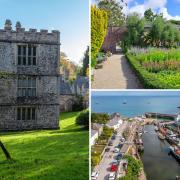Truro's Royal Cornwall Museum's new permanent exhibition and gallery has a mummy at its heart, discovers Sue Bradbury
An Exhibition Unwrapped
Truro’s Royal Cornwall Museum’s new permanent exhibition and gallery has a mummy at its heart, discovers Sue Bradbury
Looking at unwrapped mummified remains it’s easy to gape at the skeleton, wonder at its enormous age and forget about the person who once lived and breathed.
Thanks to a new permanent exhibition at the Royal Cornwall Museum, Iset-tayef-nakht is now much more than a set of bones. His head has been scanned and a painstaking reconstruction carried out by specialists so now, as you enter the gallery, it is the sculptured facial image of what Iset himself looked like that welcomes you.
Iset-tayf-nakht died more than 2,500 years ago. As a part-time Egyptian priest and craftsman, he lived with his wife and family in a house on the estate of Amun, close to the home of his parents
Amun-hor and Ta-shesh. Because of the work he did, his house was probably furnished better than most with wooden beds, headrests, stools and boxes. The walls of his home, made out of bricks of Nile mud, would have been plastered and painted with patterns or scenes of nature. Small windows and roof vents would have helped to keep the property cool.
In terms of clothes, Iset who attended to the needs of the temple god Amun-Ra, would have worn linen made from flax and his shoes would have been fashioned from leather, papyrus or reeds. His diet would have been based on barley and emmer wheat, from which bread and beer were produced, and fruit, vegetables and meat would have been cooked and served in reed, pottery, stone and faience vessels, similar to those on display.
Like all Egyptians at the time, Iset would have been preoccupied with death. Life was generally short – on average about 35 years – so the possibility of living forever was something to which everyone aspired. Being prepared for the afterlife, however, involved substantial resources, time and thought. A suitable tomb had to be constructed and coffins and tomb furniture assembled.
As it turned out, Iset-tayef-nakht had longer than most to get everything ready for his journey to eternity. He was 65 when he died in 675BC and, in accordance with his plans his body was mummified and secured in first one coffin covered in painted hieroglyphs that tell us about him and his beliefs, and then a second.
The sarcophagus would have been placed in a small, undecorated, rock-cut tomb chamber along with grave goods that were later stolen.
More than 2,000 years later his bandages were removed – allegedly on the dining table of a large house in Saltash – and his beautifully preserved form donated to the Royal Institution of Cornwall.
Iset’s remains have long been the Royal Cornwall Museum’s most popular exhibit but, previously housed in a small, rather dark room on the first floor, they have never had the prominence or the context they deserve. All that changed with the formal opening of the Unwrapping the Past exhibition and gallery in June.
Funded by a grant of �233,000 from the Heritage Lottery Fund (HLF), �55,000 from the Museums, Libraries and Archives Council and �10,000 from the Foundation for Sports and the Arts, the new gallery has put Iset at the centre of a fascinating insight into the culture, language and beliefs of ancient Egypt, Rome and Greece at the Museum.
The British Museum has been heavily involved with this project, lending some wonderful artefacts to the exhibition, including a statue of the lioness goddess Sekhmet whose likeness was thought to ward off plague during the reign of Egyptian pharaoh Amenhotep III.
Visitors can discover how a mummy is made in the mummy factory, listen to great works of literature by the likes of Socrates and Plato being spoken in their native tongue and discover the Cornish monuments that were inspired by construction thousands of years ago. For children, there is also a dressing up drawer to help make the gallery experience of stepping back in time even more authentic.
Museum Director Hilary Bracegirdle says: “It’s vital for people to be able to enjoy their voyage of discovery into what living in ancient Egypt, Rome and Greece was like and that’s why it’s important for them to be able to do things like touching examples of construction materials, decoding the old languages and recreating a pyramid, Greek temple or Roman arch. We learn through experience and Unwrapping the Past is as experiential as we could possibly make it.”
Iset-tayef-nakht is no longer quite the enigma he used to be. Sensitively displayed in a tomb-like structure, he is now part of an intriguing glimpse into a time long gone by. Once a respected member of ancient Egyptian society, he has become its ambassador.
Entry to the Royal Cornwall Museum in Truro costs �5 per adult for a one year pass and is free to anyone aged 18 and under.For more information: 01872 272205


























